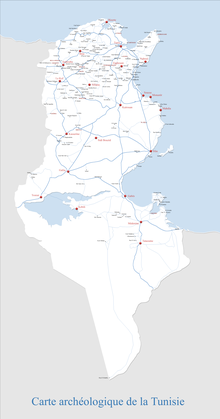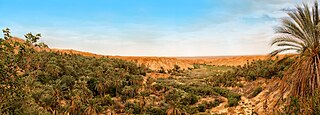
Aptuca (Africa) or Henchir Oudeka, also known as Aptucca/Aptuca, Henchir-Oudeka/Henchir-Semmech. [1] or Udeka is a village and archaeological site in Tunisia, North Africa located at 36.409344, 8.940301. [2]

Aptuca (Africa) or Henchir Oudeka, also known as Aptucca/Aptuca, Henchir-Oudeka/Henchir-Semmech. [1] or Udeka is a village and archaeological site in Tunisia, North Africa located at 36.409344, 8.940301. [2]
During Roman and Byzantine times the town was an oppidum civilium on the Oued Tessa river. [3] south east of Bulla Regis. [4] Origines Ecclesiasticae calls it 'A city in Africa Proconsilaris'. [5]
The town was also the seat of an ancient bishopric. [6] which remains a titular see of the Roman Catholic Church. Known bishops include:

Maktar or Makthar, also known by other names during antiquity, is a town and archaeological site in Siliana Governorate, Tunisia.
Mensurius was a bishop of Carthage in the early 4th century during the early Christian Church.

Negrine is a town and commune in Tébessa Province in north-eastern Algeria. It was the site of ancient Casae Nigrae, a settlement of Roman North Africa with an attached bishopric that remains a Latin Catholic titular see.

The Titular Bishopric of Vita (Vitensis) was a Roman–Berber civitas in Africa Proconsularis. It is a former Christian diocese and Latin Catholic titular see. The name 'Vita' means life.
Zattara was an ancient Roman and Byzantine town in the Africa province. It was located in present-day Kef ben-Zioune, south-east of Calama, Algeria. The city was a titular see of the Roman Catholic Church.
Rotaria was an ancient Roman and Byzantine era bishopric of Numidia, North Africa.

Henchir-El-Hatba is a village and an archaeological site in Tunisia. It was a Roman Catholic diocese.

Djebba, also known as Thigibba Bure, is a town and an ancient archaeological site is located in Bājah, Tunisia. Djebba is an archaeological/prehistoric site in Tunisia located at latitude: 36°28'32.45" longitude: 9°4'53.54" in the Béja Governorate of northwestern Tunisia. The estimated terrain elevation above sea level is 355 metres located below the slopes of Djebel Gorra, 700 meters above sea level. Djebba also has a national park, which is the subject of a development project

Purpurius was a Donatist bishop from 305 to 320 AD, who was instrumental in establishing the Donatist movement of Roman North Africa.

Centenaria was an ancient civitas (town) extant during the Roman Empire. It is tentatively identified as ruins near El Hamel Algeria. The name Centenaria derives from the Centenaria style of fortified farm, around 2000 of which were built along the Limes Africanus in Roman North Africa. Many Centenaria grew to be prosperous and large settlements.
Vagal or Vagalitanus was a Vandal and Roman era civitas (town) in Mauretania Caesariensis, Roman North Africa. The town has been tentatively identified with Sidi ben Thiour on the Mekerra River near its confluence with the Sly River.(36.073819n, 1.094881e) Nearby towns included Castellum Tingitanum and Catabum Castra (Djidioua). The mines at Malakoff were to the north-east of the town.

Vartana (Vertare[n]sis) was a Roman-Berber town in Byzacena, Africa Proconsulare. It is identified with stone ruins in the area of Srâa-Ouartane, Tunisia.

Tabala or Tablensis was an ancient city in the Roman-Berber province of Mauretania Caesariensis in modern Algeria. It was a Latin Catholic diocese.

Abbir Germaniciana also known as Abir Cella is the name of a Roman and Byzantine-era city in the Roman province of Africa proconsularis. The city was also the seat of a bishopric, in the ecclesiastical province of Carthage, and is best known as the home town of the Pre Nicaean father, Cyprian, who was bishop of Abbir Germaniciana around 250AD.

Abaradira was a Roman era city in the Roman province of Byzacena. Its exact location is unknown but it would have been in the central part of what is today Tunisia.

Pocofeltus was a Roman–Berber civitas (town) in the province of Africa Proconsularis, located in present-day Tunisia. It was also the seat of an ancient Roman Catholic diocese.

Sitipa also known as Sitipensis is a titular see of the Roman Catholic Church centered in North Africa.

Muzuca was a Roman Town of the Roman province of Byzacena during late antiquity. The town has tentatively been identified with the ruins at Henchir-Besra in modern Tunisia. Very little is known of the city, though in situ epigraphical evidence gives us the name and that in late antiquity it achieved the status of Municipium.

The diocese of Tetci is a suppressed and titular see of the Roman Catholic Church. An exact location of the town is now lost to history but it was in today's Tunisia.
Anapsychia was a late Roman letter-writer, wife and widow of Marcellinus of Carthage, and correspondent of Jerome of Stridon.